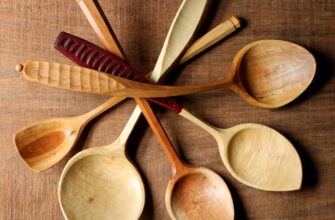Does Douglas Fir stain well? The purpose of this article is to serve as a comprehensive guide for those looking to unlock the full potential of Douglas Fir wood surface through the staining process.
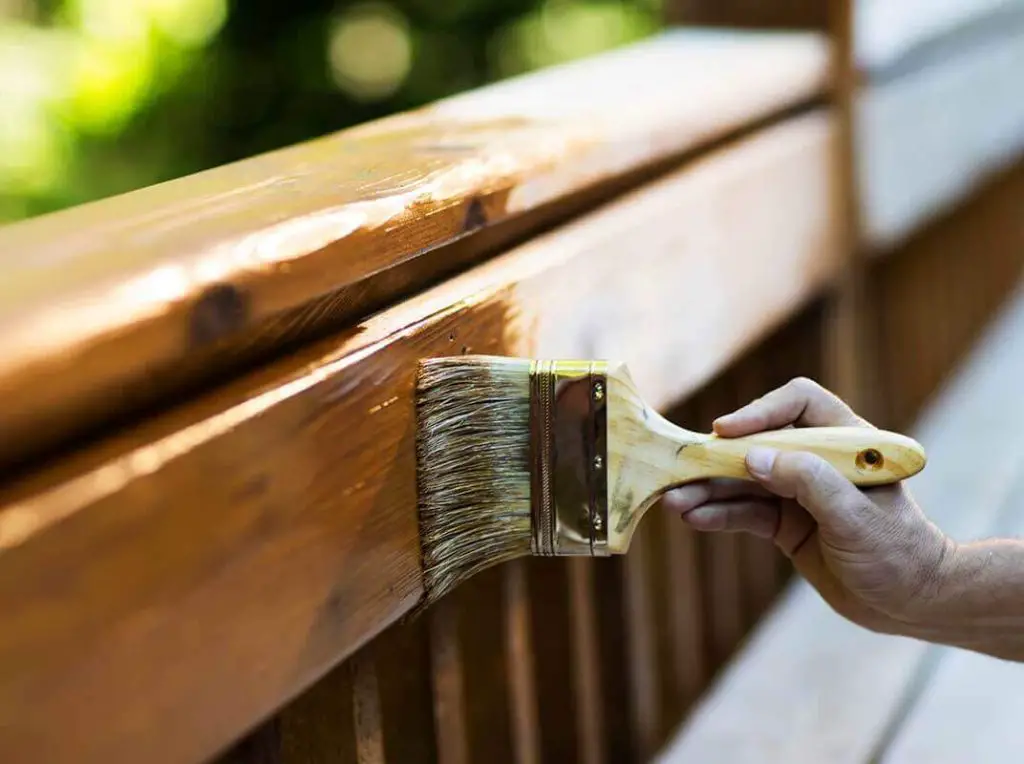
We aim to equip you with the knowledge, tips, and techniques needed to do it effectively.
- Does Douglas Fir stain well: Douglas Fir properties
- Strength and durability
- Wood grain pattern
- Color palette
- Texture
- Staining Douglas Fir
- Proper preparation before using wood stains
- Sanding and surface preparation for Staining Douglas Fir
- Choosing the right type of stain
- Detailed steps of the staining process
- Applying wood stains
- Techniques for achieving an even finish
- Drying and curing time
- Staining options
- Different types of stain for Douglas Fir
- Oil-based stain for Douglas Fir
- Water-based stain
- Gel stain for Douglas Fir
- Penetrating stain
- Pros and cons of each type
- Oil-based stains
- Water-based stains
- Gel stains
- Penetrating stain
- Tips for choosing the right stain color
- Complementing your design and decor
- Color palette
- Style and mood
- Lighting conditions
- Enhancing or preserving the natural beauty of Douglas Fir
- Enhancing natural beauty
- Preserving natural beauty
- Maintenance and longevity
- How to care for stained Douglas Fir surfaces
- Regular cleaning
- Gentle cleaning solutions
- Avoid scratches and dents
- Reapply protective coats
- Tips for extending the lifespan of the stain
- Troubleshooting
- Common issues and problems when staining Douglas Fir
- Solutions and tips for addressing staining challenges
- Conclusion
- FAQ
- How does Douglas fir look stained?
- What is the best stain for Douglas fir wood?
- What are the disadvantages of Douglas fir wood?
- How long to wait to stain Douglas fir?
- How to stain Douglas fir grey?
- What is the difference between fir and pine wood?
- What is the best pine wood stain?
- How to use gel stain for Douglas Fir?
- How to apply wood conditioner on the Douglas Fir?
Does Douglas Fir stain well: Douglas Fir properties
When considering the art of staining Douglas Fir wood surface, a fundamental understanding of the wood’s unique properties and characteristics is essential.
Softwoods like Douglas Fir (Pseudotsuga menziesii), which are native to North America’s Pacific Northwest, are prized for their adaptability and unspoiled beauty.
In the world of woodworking, Douglas Fir is a unique wood species with remarkable qualities that make it more than simply any softwood.
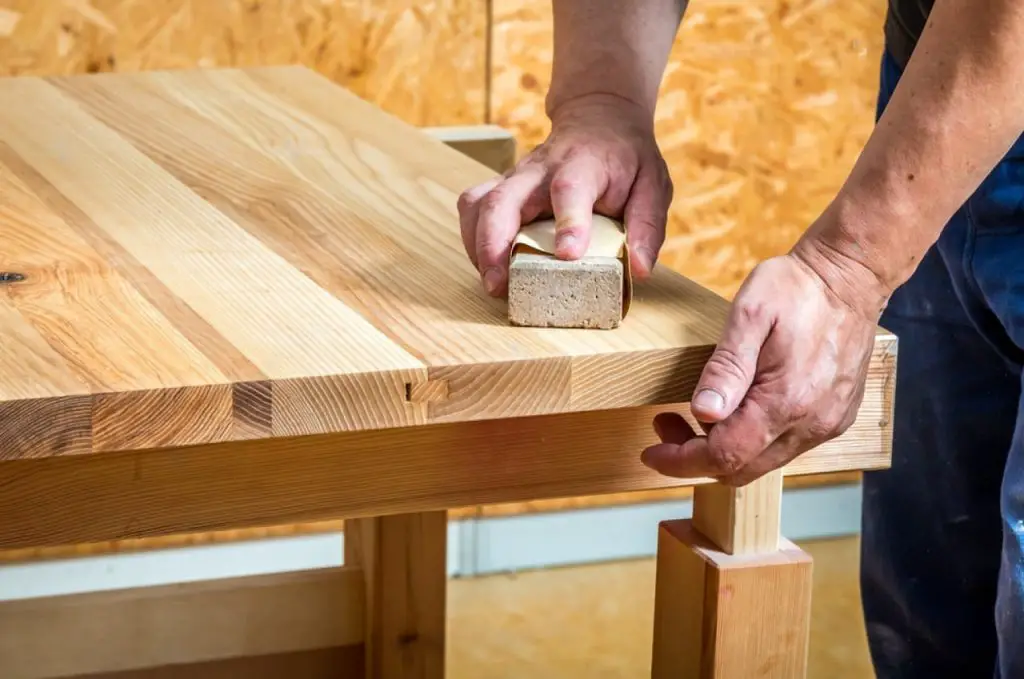
To stain Douglas Fir wood successfully, it’s important to understand the following qualities and traits.
Strength and durability
Douglas Fir is celebrated for its strength and resilience.
Because of its structural integrity, it is a well-liked option for applications including flooring, framing, and beams where strength and durability are crucial.
Wood grain pattern
The Douglas Fir wood surface has an attractive and useful wood grain design. Its fine-grain, straight lines provide a visually appealing consistency that takes dye very well.
Comprehending the wood surface’s grain pattern is essential to attaining a smooth and visually pleasing finish.
Color palette
The natural color of Douglas Fir wood surface is a significant factor when choosing the right stain.
Douglas Fir dark reddish-brown and amber hues create a warm and inviting canvas for your staining endeavors.
Texture
Douglas Fir wood surfaces have a fine to medium texture, which makes them a great option for a variety of woodworking applications.
Staining Douglas Fir
In this section, we will guide you through the essential steps of staining Douglas Fir effectively, from the critical preparatory work to the finishing touches.
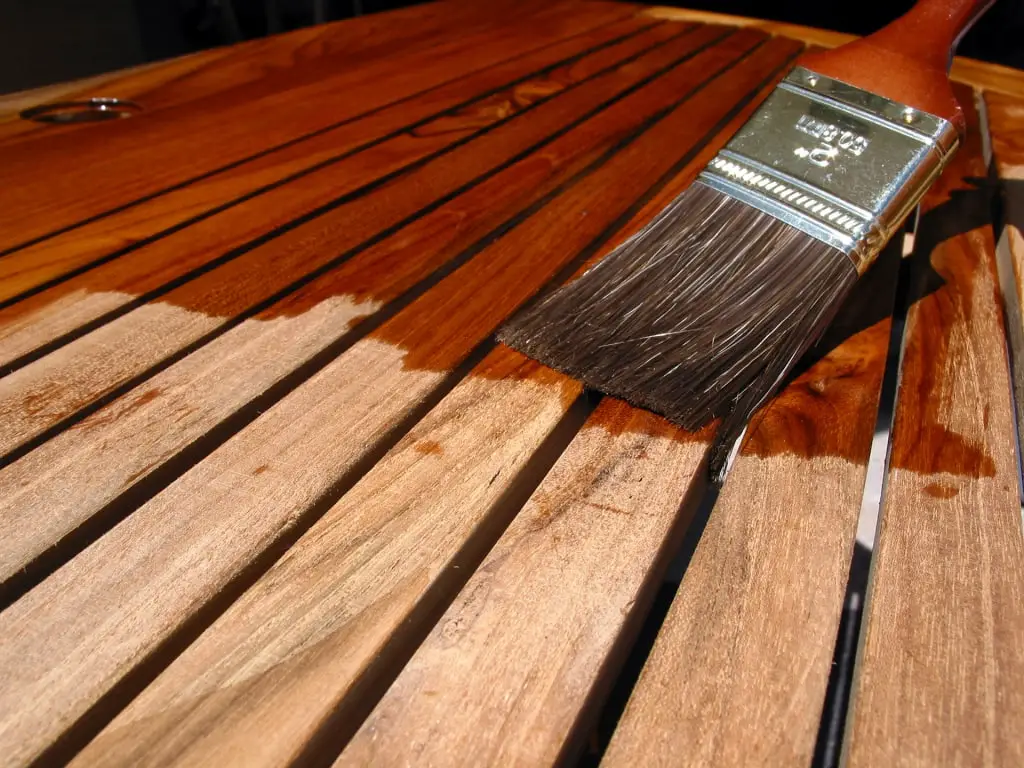
Proper preparation before using wood stains
Before you even think about opening a can of stain for Staining Douglas Fir, it’s crucial to understand the significance of thorough preparation.
Sanding and surface preparation for Staining Douglas Fir
An essential first stage in the staining process is sanding. Sanding will cause the wood pores to open, letting the stain in.
Examine your Douglas Fir project first for any flaws, such as uneven sections, knots, or rough patches.
High-grit sandpapers can seal the wood pores, making it more difficult for the wood stain to penetrate. Steer clear of these.
Verify that the surface is sufficiently smooth and that the wood pores can be seen for the conditioner to absorb.
By doing this, you provide the stain an even surface on which to work, enabling it to enter the sanded wood evenly and take on a glossy appearance.
Choosing the right type of stain
Your project’s ultimate appearance is greatly influenced by the stain type you select.
There are several stain choices, each having unique qualities, such as oil-based, water-based, and gel stains.

Detailed steps of the staining process
Now that we’ve explored the characteristics of Douglas Fir and taken the necessary preparation steps, it’s time to delve into the heart of the matter – the staining process.
Staining is an art, a careful interplay of preparation and execution that can transform your Douglas Fir projects into stunning masterpieces.
Applying wood stains
Before applying the wood stain, apply a wood conditioner. Douglas Fir requires it because of its uneven texture and wood pores.
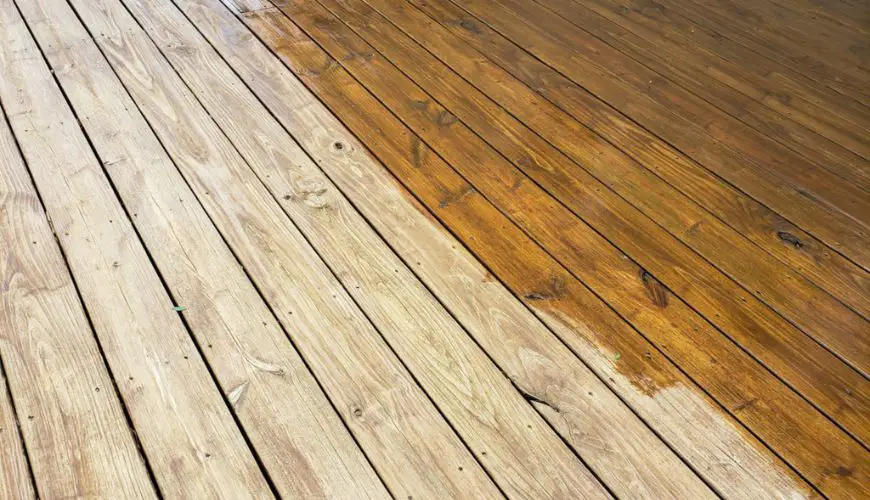
Once your preparation work is complete and you’ve chosen the appropriate stain, it’s time to apply wood stain on the sanded wood. Use a clean, lint-free cloth, a brush, or a sponge to apply the stain in the direction of the wood grain.
Techniques for achieving an even finish
The characteristic of a well-stained Douglas Fir project is achieving an even finish. To attain a more translucent finish, take into consideration methods like “wiping stains,” which include removing excess stain after a few minutes.
Alternatively, you can apply numerous coats of stain if you want a deeper, richer color. Your final appearance should be in line with the approaches you use.
Drying and curing time
It’s critical to give the stain enough time to dry and cure after application. The type of stain and the surrounding circumstances can affect how long it takes to dry.
Ensure that you adhere to the drying and curing time recommendations provided by the manufacturer. If this stage is rushed, the Douglas Fir surface may have an uneven finish and unappealing imperfections.
Staining options
As you embark on your journey to stain Douglas Fir wood, one of the key decisions you’ll face is selecting the right type of stain.
In this section, we’ll explore the various staining options available for Douglas Fir.
Different types of stain for Douglas Fir
Several types of stains can be used for Douglas Fir.
Oil-based stain for Douglas Fir
Characteristics: oil stain is known for its rich and deep color penetration. Oil stain contains natural oils or synthetic resins that make the wood absorb stain and allow the stain to seep into the wood’s grain, enhancing its natural beauty.
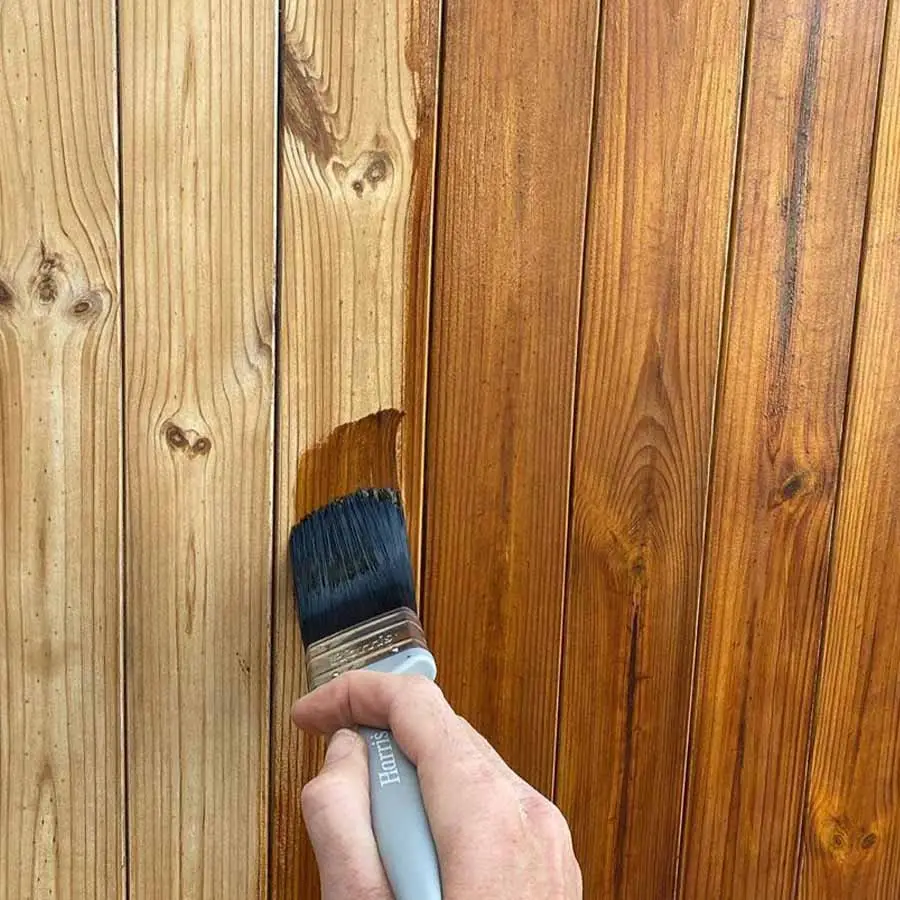
Considerations: these stains often require longer drying times, and they emit volatile organic compounds (VOCs), which can be a concern in enclosed spaces.
Water-based stain
Characteristics: water-based stains use water as a carrier for pigments or dyes. They are known for their low odor and quick drying time.
Considerations: they may not penetrate the wood as deeply as oil-based stains, which can result in a lighter, less rich appearance.
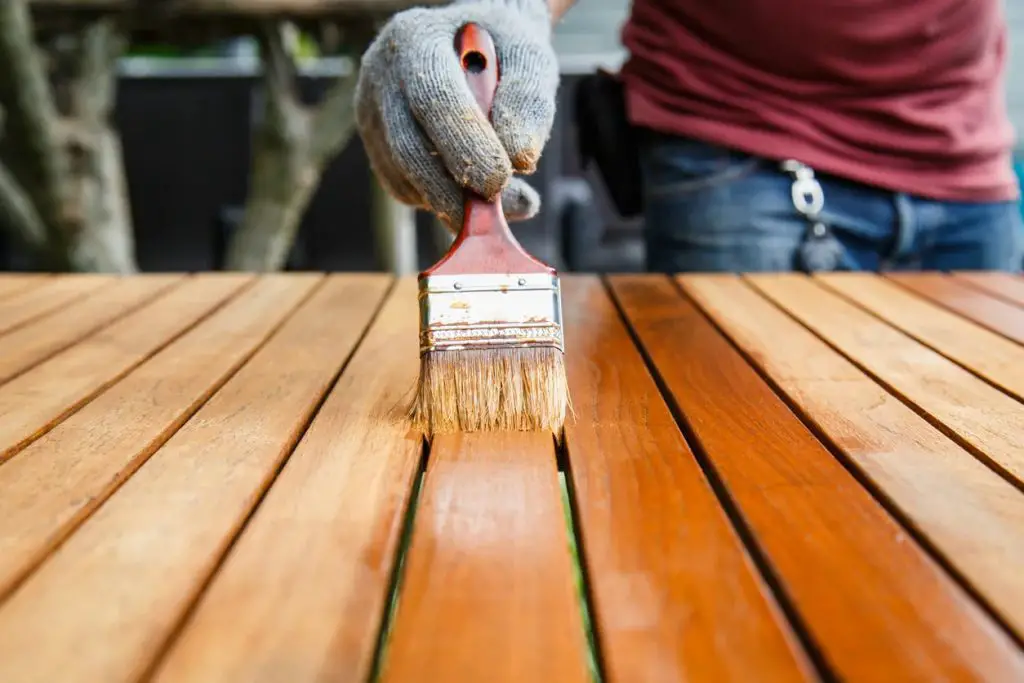
Gel stain for Douglas Fir
Characteristics: the gel stain has a thicker consistency, similar to a soft gel. The texture of the gel stain makes gel stain ideal for vertical surfaces and projects where precision is required.
Considerations: the thicker consistency of gel stain may obscure some of the wood’s natural grain patterns, and achieving a completely uniform finish can be more challenging with gel stain.
Penetrating stain
Characteristics: penetrating stain absorbs into the wood fibers, enhances the natural grain, provides a semi-transparent or transparent finish, retains the wood texture and feel, is typically oil-based or water-based, and requires maintenance over time.
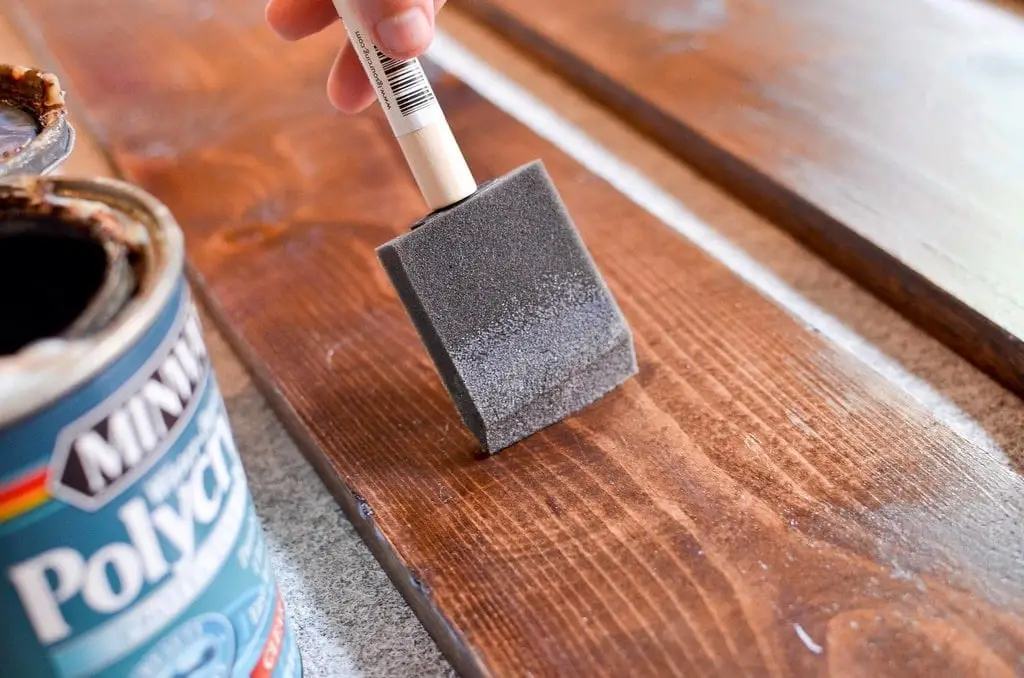
Considerations: deeply ingrained in the wood, penetrating stain brings out the original texture and grain. Because these stains are less likely to produce a surface coating, they may be the material of choice for those who want a more rustic, natural look.
Pros and cons of each type
Below are listed the potential advantages and drawbacks of different stains that we’ve discussed.
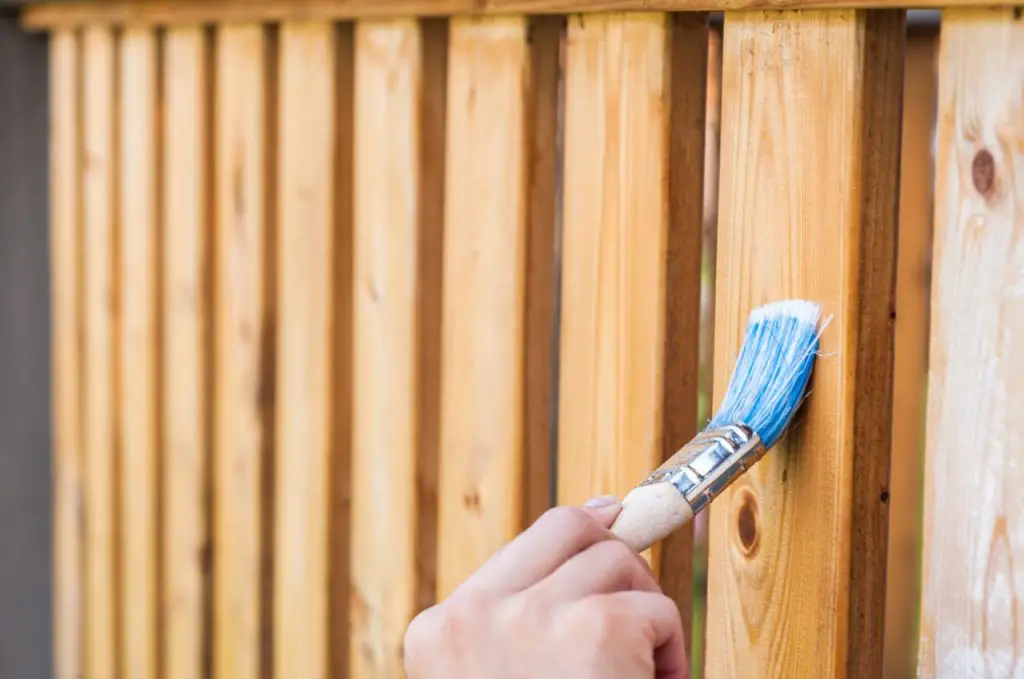
Oil-based stains
Water-based stains
Gel stains
Penetrating stain
Understanding the advantages and potential drawbacks of each type will empower you to make an informed decision and achieve the desired finish for your Douglas Fir furniture.
Tips for choosing the right stain color
Selecting the right color is a pivotal decision when it comes to staining Douglas Fir.
Complementing your design and decor
When choosing a color, it’s essential to consider the existing design and décor elements of the space or project where your Douglas Fir will be used.

Here are some tips for ensuring your stain complements the surroundings.
Color palette
Take stock of the predominant colors in your room or design. A harmonious color should either blend seamlessly with these colors or provide a pleasing contrast if that’s the effect you desire.
Style and mood
Consider the style and mood you want to convey. Dark stains can create a cozy, rustic atmosphere, while lighter stains can offer a more contemporary, airy feel.
Lighting conditions
The type and amount of natural and artificial lighting in the space can significantly affect how the color appears.
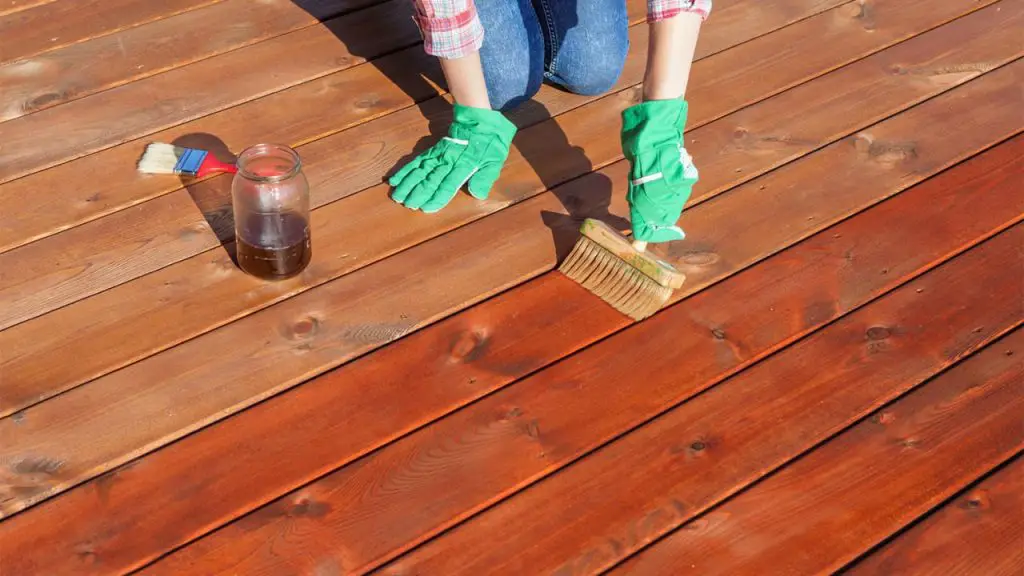
Test samples in the actual environment to see how they look under different lighting conditions.
Enhancing or preserving the natural beauty of Douglas Fir
Douglas Fir possesses its inherent beauty with its reddish-brown to amber hues and striking grain pattern.
When staining Douglas Fir, you have the option to either enhance these natural qualities or preserve them while subtly altering the color.
Enhancing natural beauty
To bring out the wood’s natural warmth and charm, opt for a stain color that is closely aligned with its existing color palette.
This approach enhances the wood’s natural features and adds a protective layer to extend its longevity.
Preserving natural beauty
If you wish to preserve the wood’s natural appearance, consider using a clear or transparent stain.
These options protect against wear and tear while allowing the wood’s original color and grain to shine through.
By carefully considering these tips, you can make an informed decision about stain color that aligns with your design vision, harmonizes with your space, and showcases the unique beauty of Douglas Fir.
Your choice of stain color can truly define the final look and feel of your project.
Maintenance and longevity
Once you’ve successfully stained your Douglas Fir surface, the work isn’t over.
In this section, we’ll delve into the best practices for preserving the appearance of your stained Douglas Fir surfaces and extending the longevity of the stain.
How to care for stained Douglas Fir surfaces
Maintaining stained Douglas Fir surfaces is essential to keep them looking their best and to protect the wood from wear and tear.

Regular cleaning
Dust and dirt can accumulate on the surface, diminishing the appearance of the stain.
Regularly dust or wipe down your stained surfaces with a clean, dry cloth or a slightly damp cloth to remove any particles.
Gentle cleaning solutions
When necessary, use a mild, pH-neutral wood cleaner to remove stains, spills, or sticky residue. Avoid harsh chemicals that can damage the finish.
Avoid scratches and dents
Take care to prevent scratches and dents by using protective pads on furniture legs, handling objects with care, and placing mats or rugs in high-traffic areas.

Reapply protective coats
Over time, the protective topcoat of the stain can wear down. Depending on the level of wear, you may need to reapply a topcoat of the same stain or finish to maintain the wood’s protection and sheen.
Just remember to let the wood dry before applying additional coats.
Tips for extending the lifespan of the stain
While proper maintenance is vital, there are additional steps you can take to ensure the longevity of the stain itself:
- Use high-quality stains and finishes: choosing high-quality stains and finishes from reputable manufacturers can make a significant difference in the durability and longevity of your stain.
- Apply multiple coats: applying multiple coats of stain can offer added protection and durability (for example, Douglas Fir floors and a Douglas Fir deck require multiple coats). Let the wood dry between coats. Follow the manufacturer’s instructions regarding drying times between coats.
- Protect from UV exposure: direct sunlight can cause the color of your stained wood to fade over time. Use window treatments like curtains or blinds to shield the wood from excessive UV exposure.
- Regular inspections: periodically inspect your stained surfaces for signs of wear, damage, or areas where the stain may need touch-ups. Addressing issues promptly can prevent more significant problems down the road.
By following these maintenance tips and taking precautions to protect your stained Douglas Fir surfaces, you can ensure that your projects continue to shine and endure the test of time.
Troubleshooting
Even with careful planning and execution, challenges can arise when staining Douglas Fir.
Common issues and problems when staining Douglas Fir
Uneven stain absorption: Douglas Fir’s unique grain patterns and density can lead to uneven stain absorption, resulting in blotchy or streaky finishes.

Blotching and irregular color: inconsistent coloration can occur when the stain is not applied evenly or when the wood absorbs the stain unevenly.
Excessive stain penetration: stains may penetrate the wood too deeply, leading to a darker and unintended color.
Drips and runs: over-application or improper technique can cause drips and runs, leaving unsightly blemishes on the wood.
Inadequate drying or curing: rushing through the drying and curing process can lead to issues like tacky or sticky surfaces and reduced durability.
Solutions and tips for addressing staining challenges
Uneven stain absorption: precondition the wood properly with a pre-stain wood conditioner to help achieve uniform stain absorption. This minimizes blotching.
Blotching and irregular color: apply a thin, even layer of stain and wipe off any excess. Alternatively, consider using a gel stain, which tends to be less prone to blotching.
Excessive stain penetration: if the stain is too dark, you can partially remove it with a stain remover or sanding. Next time, apply lighter coats or choose a lighter stain.
Drips and runs: be mindful of the amount of stain applied, wipe off excess, and maintain a consistent technique. Sanding may be required to fix runs.
Inadequate drying or curing: always follow the manufacturer’s recommended drying and curing times. Ensure proper ventilation to expedite the drying process.
Fading over time: to prevent UV-induced fading, use UV-resistant finishes and protect your stained surfaces from direct sunlight using window coverings.
Stain compatibility: ensure that the stain you choose is compatible with the previous finish or stain on your wood project. Test a small, inconspicuous area before proceeding.
By following these solutions and tips, you can overcome hurdles and achieve the desired results when you stain Douglas Fir.
Conclusion
In your journey to stain Douglas Fir wood, remember that the process is as much about the craftsmanship as it is about the final result. With the knowledge and insights provided in this guide, you can approach your projects with confidence and creativity, turning your wood into stunning, enduring works of art.
FAQ
How does Douglas fir look stained?
When stained, Douglas Fir wood can take on a variety of appearances depending on the stain type and color chosen.
Generally, the wood’s grain pattern becomes more pronounced, and its color deepens.
What is the best stain for Douglas fir wood?
The choice of the best stain for Douglas Fir wood depends on your specific project and aesthetic preferences.
Generally, oil-based stains are popular for their rich color penetration and durability.
Water-based stains are eco-friendly and have a quick drying time.
Gel stains provide more control over application and can prevent drips.
Examples include Minwax stain which is considered the best wood stain. The Minwax stain provides great coverage with a rich color, like early American stain (such as dark walnut stain).
What are the disadvantages of Douglas fir wood?
While Douglas Fir is a popular wood choice, it’s essential to be aware of its potential drawbacks. Some disadvantages include:
Susceptibility to knots and irregular grain patterns.
A tendency to splinter when not properly handled.
Can be more challenging to work with than other woods due to its hardness.
How long to wait to stain Douglas fir?
In general, after sanding and preparing the wood properly, you should wait for the surface to be completely dry and free of moisture or debris before applying the stain.
This can take several hours (like with a Douglas Fir deck) to a day or longer.
How to stain Douglas fir grey?
To stain Douglas Fir grey, you can use a grey wood stain (for example, gel stain) or a weathered wood finish.
What is the difference between fir and pine wood?
Fir wood is typically denser and stronger than pine wood. Fir has a straight, fine grain, while pine has a variety of species with different appearances.
What is the best pine wood stain?
The best wood stain for pine depends on your specific project and desired finish. Consider factors like color, type of stain, and your project’s requirements when choosing the wood stain.
How to use gel stain for Douglas Fir?
To use gel stain on Douglas Fir:
Sand the wood surface and clean it thoroughly.
Apply gel stain: using a brush or cloth, apply the gel stain evenly, working in the direction of the grain.
Wipe off excess gel stain: after a few minutes, wipe off any excess gel stain to achieve the desired color depth.
Let the gel stain dry according to the manufacturer’s instructions.
Once the gel stain is dry, consider applying a topcoat for added protection and sheen.
How to apply wood conditioner on the Douglas Fir?
To apply wood conditioner on the Douglas Fir:
Ensure the Douglas Fir is clean and sanded before using wood conditioner.
Stir the wood conditioner: mix the wood conditioner thoroughly.
Apply a thin coat of the wood conditioner: use a brush, cloth, or sponge to apply a thin and even coat of wood conditioner to the wood surface.
After a few minutes, wipe off any excess wood conditioner with a clean cloth.
Let the wood conditioner soak into the wood for the recommended time, typically 15-30 minutes.
Proceed with applying the stain (for example, the gel stain).


![How Long Does Wood Siding Last? [3 Lifespan Secrets] How Long Does Wood Siding Last: The Best Guide 2024](https://bestwoodforcarving.com/wp-content/uploads/2024/01/How-Long-Does-Wood-Siding-Last-3-Lifespan-Secrets-335x220.jpg)
![Examine [5+ tools and techniques] to cut square hole in wood Cut Square Hole In Wood: 5 Best Ways To Do It Perfectly](https://bestwoodforcarving.com/wp-content/uploads/2024/01/cut-square-335x220.jpg)
![Burn, laser, tool, CNC, hand wood engraving [5 ways explained] Hand Wood Engraving And Other Best Ways To Work With Wood 2024](https://bestwoodforcarving.com/wp-content/uploads/2024/04/bestwoodforcarving.com_-335x220.jpg)

![How long for wood filler to dry? [Tips & Tricks] wood 26](https://bestwoodforcarving.com/wp-content/uploads/2024/01/wood-26-335x220.jpg)

![How to remove white spots from wood furniture? [10 super-easy methods] How To Remove White Spots From Wood : Top 10 Best Tips](https://bestwoodforcarving.com/wp-content/uploads/2023/12/wood-12-335x220.jpg)
